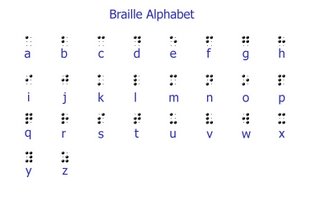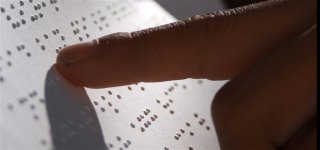Six dots that open the world


The holidays often bring news from friends in all corners of the world, and this year was no exception. One of the most fascinating updates was from a friend living in East Lansing, Michigan, where I attended graduate school at Michigan State University. I met her when I was studying at the MSU-DOE Plant Research Laboratory. A member of the talented staff who keep the institute running, she is a scientific editor and often lent her keen eyes to my first manuscripts. She wrote this year to describe dual and overlapping interests, music and Braille:
“Personally, my life is becoming ever more centered around music. I continue to struggle through violin lessons (with a most wonderfully patient teacher), and to play in a quartet and community orchestra--so thrilling! About five years ago, I was certified as a braille transcriber and joined a group of braillists transcribing textbooks into braille for students. That group disbanded last fall, as most of the younger members were in their 70s and had been brailling for decades. So, I decided to pursue my original idea, which was to work toward certification in music braille. I have read that there are fewer than 40 people in the country who have such certification, so the need is great. I am constantly overwhelmed by the ingenuity of Louis Braille, who devised both of these systems of representation by dots. A braille cell has only six dots, and yet a sheet of music, with different voices, lyrics, whatever, can be reproduced in a series of braille cells. Of course, it's incredibly complex and there are days when I wonder how I could have imagined this old dog could learn a new "language" at my age, but I also really enjoy working at it. It seems to satisfy my urge to work crossword puzzles, yet has the added attraction of being potentially useful. If I manage to finish the course, that is. :)
January 4, 2009, is the 200th anniversary of Louis Braille's birth and the National Federation of the Blind is sponsoring initiatives designed to bring the importance of braille literacy for blind children to national attention. You can view a very moving video, "Braille: Unlocking the Code," on the NFB website: http://www.nfb.org/nfb/Braille_Initiative.asp. In March, a limited edition coin commemorating Braille's birth will be issued to raise awareness of the needs of blind people.”
My friend’s letter prompted me to learn more about the braille system and the life of Louis Braille. Interestingly, the precursor of the Braille system was a method of military communication developed by Charles Barbier de la Serre for Napoleon’s army called “night writing”. Berbier’s method used a series of twelve raised dots to represent 36 sounds. The military desired such a system so that soldiers could communicate battle plans at night silently, without need for illumination. However, when Berbier demonstrated his system to Louis and other students at the Royal Institute for Blind Children in Paris, Louis immediately realized why the system failed to be adopted: the human finger could not accommodate twelve dots, and the code was too complex. By the age of 15, Louis had developed a new method that relied on a six-dot cell. Braille and its precursors are thought by some linguistic experts to be the first example of a binary written language system in history. In current usage, the English alphabet braille system includes contractions and contextual meaning for needed brevity.
Though Braille’s innovative contribution was enormous, it does not appear that he (a French citizen) ever sought a U.S. patent claiming the braille system, although he did publish a book in 1829 about the system titled “Method of Writing Words, Music, and Plain Songs by Means of Dots, for Use by the Blind and Arranged for Them”. However, a search of the US Patent and Trademark Office site of issued patents with the term “braille” returns 1907 patents, ranging in date from 1926 to the present. Examples include display apparatuses for the braille system, writing devices and printing systems, and even a chess set incorporating braille notation (US Pat. No. 7,347,421).
If you are interested in becoming a certified braille transcriptionist, you can find more information from the National Federation of the Blind. Madison residents can attend a local Braille celebration event hosted by the Wisconsin Council of the Blind and Visually Impaired this Wednesday, January 7; for more information, see
http://www.madison.com/wsj/home/local/430490. If you don’t live in the Madison area, check around for a local event – celebrations and information sessions are being held nationwide.
Labels: braille, history, innovation


0 Comments:
Post a Comment
<< Home